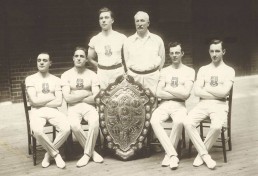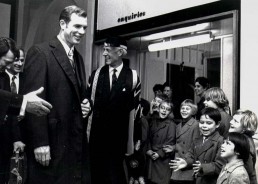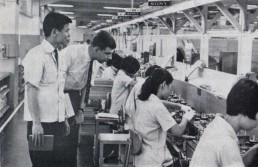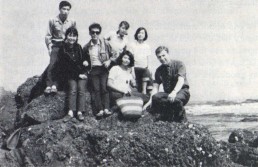First Principal’s pioneering international perspective
While many universities today proclaim to have strong international outlooks, City can truly say its international roots date back to its very foundation. Dr Robert Mullineux Walmsley, the first Principal of the Northampton Institute, as City was then known, brought a pioneering international perspective, which has been a constant theme in the City story. This international view was no doubt formed by one of his earlier appointments – a brief spell as Principal of Sindh Arts College, based in Karachi, Pakistan.
Walmsley also travelled extensively. Following a three-month tour of technical education institutions in the United States in 1903, he introduced the concept of sandwich courses to the UK. He returned from his trip so impressed by what he saw that he proposed that mechanical and electrical engineering courses be extended to four years’ duration, with students spending five to six months of their second and third years on placement at commercial organisations and workshops.
Each year, Walmsley personally visited students during their placements across the UK and abroad. He visited one student who spent their placement in Austria during 1905/06 and another who headed to Genoa, to work for Italian State Railways during 1908/09. Both students travelled to their respective host countries in the engine room of passenger ships.
Walmsley carried out his visits during his holidays with the Institute covering his expenses. When an industry-wide lockout of engineers in 1922 made it difficult to find domestic placements for students, Walmsley dispatched the Head of the Mechanical Engineering Department to Belgium and Switzerland and industrial experience was subsequently arranged for 13 students.
Welcoming the world to the Northampton Institute for the 1908 Olympics
In 1908, also during Walmsley’s leadership, the University Great Hall, in College Building, played host to the boxing competition of the first London Olympic Games, hosting boxers (and supporters) from England, Wales, Scotland, France, Denmark and Australia. The University swimming pool, also in College Building and now a study area, was also used for the Olympic Games.
In the same year, the Northampton Institute, was awarded the Diploma of Honour for its exhibit at the Franco-British Exhibition, held in London to celebrate the signing of the Entente Cordial between the UK and France.

Early international staff
Today, 28% of City staff are from outside the UK and there is evidence that international staff are not new to City. The world-famous German gymnast, Rudolf Oberholzer (pictured third from right) was appointed as Director of Exercises in 1896, a position he held until his retirement in 1929 at the age of 67. A commemorative plaque of polished granite was erected in the gymnasium in 1932 in recognition of his work. The plaque is still on display today, at the entrance to CitySport.
Through the work of Oberholzer, the Northampton Institute was recognised as laying the foundations of British Olympic Gymnastics, with Oberholzer often referred to as the father of British gymnastics.
A long history of international visitors to City
Today, City hosts numerous visits from international institutions each year. Recent discussions with current and prospective partners have included colleagues from Switzerland, Morocco, Canada and China. There are examples of similar visits throughout our history, including a 1913 visit by a member of the US Navy, J.G. Hunsaker. He was sent by the President of the Massachusetts Institute of Technology (MIT) to study the aeronautics courses founded by Frederick Handley Page, with a view to establishing courses and a research laboratory in Boston. In a letter to Dr Walmsley, Hunsaker wrote “I was much pleased and surprised to find the work at your Institute so complete. I believe it is the only complete course in theory and design that is available.”
This suggests that Handley Page and the Northampton Institute may have inspired and informed aeronautical engineering education at MIT, where the Department of Aeronautics and Astronautics traces its roots to 1914, the oldest programme of its kind in the US.
NASA astronauts visit City
Nearly sixty years later, in 1971, City hosted more visitors from the United States when the three-man crew of Apollo 15, recently back from the fourth landing on the Moon, visited during a scientific tour of Britain. The crew gave a lecture, presented Vice-Chancellor Sir James Tait with a piece of heat shield from the command module and brought with them a sample of moon rock.

Sending students out into the world
City students have travelled abroad during their course throughout City’s history. For nearly fifty years, beginning in the early 1950s, annual trips were supported by a travel bursary founded by alumni known as the ‘old Northamptonions’ to commemorate former students who lost their lives during the Second World War. The trips included investigating the French aircraft industry, marine life in the Red Sea, ancient dance in Bali and the role of women engineers in the USA.
In 1967 Anthony Eden (pictured below on his research trip), a recent graduate of the Electrical and Electronic Engineering Department, received a grant to travel to Japan to investigate the relatively new field of satellite telecommunications. While based in a research laboratory in Tokyo, he travelled extensively during the course of his five-week stay. He spent a day in Kyoto visiting classical temples and shrines, visited the northern island of Hokkaido and hiked in the mountainous region of Karuisawa. He also visited the companies Sony, Toshiba and Hitachi, as well as a satellite communications centre on the east coast. During his visit Anthony enjoyed tempura and sukiyaki and found that “Western people were still a comparative rarity in this dynamic new country.”


Two years later £200 from the bursary contributed to the costs of four students to travel to the Guma Valley in Sierra Leone to survey a hydro-electric generating and water supply scheme in Freetown. It was hoped that the scheme would solve the drought problem in the country. A report of the eventful trip details an arduous road trip through the desert from Morocco, witnessing illegal diamond mining and being held up by bandits.
The first record of a student exchange at City took place with Worcester Polytechnic Institute in the USA in 1971/72. City students spent six months there, with each institution waiving course fees. The scheme provided “valuable educational and social experience and soon extended to staff visits and exchanges” as well as links with other institutions abroad.
Today City has mobility agreements for staff and students with over 120 international partners.
As these insights from the archive show, City’s international outlook is not a new phenomenon but a central part of our proud heritage.
Read more about City’s current international activity here: www.city.ac.uk/about/global-city